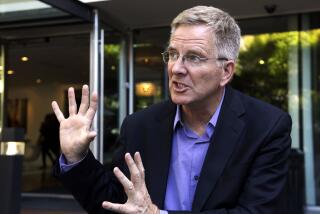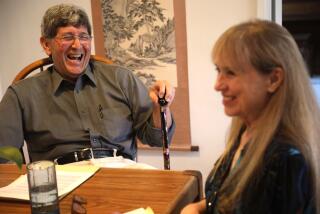Act? Wait? It can be your choice
IT was, many physicians would say, the right thing for a man of 53 to do. So Larry Cano had a prostate-specific antigen, or PSA, test. “It was 5.3,” says Cano, a film producer from Newport Beach. “They say anything over 4 is noteworthy.”
The noteworthy result, followed by a positive biopsy, sent Cano pinballing from surgeon to radiologist and back with what he believes, three years later, was an exaggerated sense of urgency.
He may have been right. Researchers -- and a few doctors -- are beginning to agree: Even many younger men with prostate cancer can afford to wait.
“Most of the time, I tell men that they may need treatment, but they’re not going to die,” says Mark Scholz, a Marina del Rey oncologist, specializing in prostate cancer. “A lot of men with low-grade cancer may not need treatment for five to 10 years.”
Some may never need it.
No one initially told Cano that his prostate cancer was not an emergency, that he had time to talk to men who had been through the same diagnosis, to do his own research, to take a deep breath and think about how he wanted to live the rest of his life. No one told him that he could leave his prostate intact, right where it was, while carefully monitoring his condition -- and that he might be able to do that for quite a long time. Maybe forever.
Cano didn’t fit the profile of the traditional candidate for what’s called watchful waiting, an option that has become synonymous with doing nothing. That approach has been recommended for older men or those threatened by other diseases.
Men like him -- younger, healthier men diagnosed with earlier stages of cancer -- are typically urged to act quickly. They represent the changing demographic of the disease and, like Cano, often feel lucky to catch it early. Cano even made an appointment for surgery. “I thought, just buck up and get it done,” he says.
But then he took some time to think again. He did a lot of reading, weighed risks and benefits, and ultimately decided on a form of waiting that is anything but passive.
What Cano chose represents the newest thinking in the disease, and the approach is so different from watchful waiting that no one calls it that any more. They call it active surveillance.
Three years later, his prostate is still where nature put it, he feels fine, and he has become a diligent student of his medically relevant numbers. So far, his cancer is not progressing.
Theoretically, half of men diagnosed with the disease have caught it early enough to at least try active surveillance. The prostate stays, and the patient and his doctors regularly hover over new test numbers and images, on the alert for any sign of change. But only about 12% of such men go that route.
Cano knows full well that he is trading the treatment risks -- impotence and incontinence -- for the risk of waiting too long and missing the best opportunity to cure his cancer. For his choice to pay off, he has to monitor his condition on a tight schedule, and be ready to act if it changes -- all the while hoping for the good luck of slow-growing cancer cells.
Such monitoring of early disease, increasingly debated in the inner sanctum of medical meetings and on the pages of scientific journals, rarely makes its way to the list of choices offered to patients. In fact, the number of men choosing to wait is going down, according to a federal database, even as the number of younger men with low-risk disease is going up.
No one argues that men with more advanced disease ought to make a treatment decision soon. But the growing number of men who are finding out in their 50s and 60s that they have early-stage prostate cancer are also routinely being urged toward surgery or radiation soon after diagnosis, even though medicine currently offers no way of knowing for sure who needs treatment and who doesn’t.
It’s little wonder, then, that about 150,000 of the 234,460 men diagnosed with the disease each year move quickly to have surgery, radiation seed implants, or one of a variety of other radiation techniques.
“Of the rest, probably about half get hormone treatments and half get watched,” says Scholz, Cano’s physician. Those watched are typically elderly or have other life-threatening conditions. And they are watched in the old way. “Too much waiting and not enough watching,” says Peter Carroll, urologist at UC San Francisco.
Adding confusion to men’s hurried decisions, medical science offers no definitive answers to who is a good candidate for surgery, or who might do better with radiation, because there has never been a head-to-head clinical trial of surgery versus the different forms of radiation.
“Neither side wants to find out the other one is better,” says Dr. Stephen Doggett, a Tustin radiologist whose practice consists of providing brachytherapy, the implantation of radiation seeds into the prostate. “No one has ever proven that one is better than the other.”
But for some men, neither a rush to treatment nor the old, passive wait-and-see approach is appropriate. “I spend half my time talking guys down out of the tree,” Scholz says. If surgical or radiation treatment were akin to, say, treatment for basal cell carcinoma in which the common skin tumors are removed and the patient suffers no serious consequences, then early diagnosis followed by universal treatment would be a no-brainer. But with prostate cancer, the usual treatments can have emasculating side effects. “If we had a nontoxic treatment, you wouldn’t care,” Scholz says. “But we’re making them impotent, making them leak urine.”
“It’s a chink in the armor of manhood,” Cano says. “It’s a dastardly disease that affects you in the seat of what some people conceive of as maleness. It can affect your sexual function, and then evolve into something that can kill you. You’re damned if you do, and damned if you don’t.”
*
Risks of treatment
Because the prostate sits so near the nerves that govern erection as well as the ability to control urine flow, it takes great finesse to remove or destroy the 1 1/2 inch-long gland while leaving those nerves intact.
Some physicians -- prostate cancer support groups call them medical artists -- have decades of experience with thousands of either surgical or radiological patients, and, using techniques that spare the nerves near the prostate, end up with a far lower incidence of impotence and incontinence.
But the national averages for side effects remain grim. More than half of treated men will have permanent sexual dysfunction, and up to 30% will have some degree of chronic urinary incontinence. Most of them will be cured of their cancer, though an unknown number won’t know that they didn’t need the cure. And a small number of men getting surgery or radiation will have cancer that has already spread beyond the prostate. For them, the ultimate indignity is that they could well suffer side effects of treatment, and still have a growing cancer in their bodies.
In a study begun in 1996, Dr. Laurence Klotz, urology professor at the University of Toronto, has been attempting to shed light on the gray area of who needs treatment and who will live a long, healthy life without treatment. Men who are good candidates for waiting are those with a PSA of less than 10; a Gleason score, the number used to grade prostate cancer for potential aggressiveness, of less than 6; and fewer than a third of cores taken in biopsy with cancer cells.
Follow-up monitoring includes a PSA test every three months, and periodic repeat biopsies.
Deemed good candidates, the 500 men in Klotz’s study waited, as Cano is doing, and chose a therapy only if their cancer took a turn for the worse.
So far, about a third of the active surveillance group have gone on to have surgery or radiation. About 20% got treatment after experiencing a rapid doubling time of their PSA count -- that is, the number doubled in less than three years. And 5% received treatment after follow-up biopsies showed an increase in their tumor grade. PSA doubling time and increase in tumor grade are both indications that it’s time to act more aggressively.
Another group of men in the active surveillance group, with no danger signs, opted for treatment anyway. “About 12% just got nervous,” Klotz says. “It’s the word ‘cancer’ that’s a problem. The word puts into gear the whole freight train of adverse expectations about the future.”
That leaves about two-thirds of the volunteers still waiting, and still healthy. In the entire group, those remaining on active surveillance, and those treated after waiting, there has been a 99% survival rate, with three prostate cancer deaths. “And those three died very rapidly,” Klotz says. Their disease, he speculates, had likely already escaped the prostate and traveled to other parts of the body.
The study is being expanded, supported in part by the Canadian and U.S. National Cancer institutes, to look at 2,100 men. Results of that larger comparison study are years away -- not soon enough to help Cano with his decision.
*
Faced with a decision
Three years ago, Cano’s urologist did what many surgeons do. He recommended immediate surgery. A radiologist recommended radiation. Another radiologist recommended brachytherapy. A month after diagnosis, the urologist scheduled surgery because Cano thought he was ready.
He cried with his wife, went over provisions in his will, and thought about his daughter. “I was 53, happily married, and my child was 14,” he says. “I began to think that I’d rather walk her down the aisle than worry about whether I had sexual function. Having a great sex life doesn’t help you if you’re dead.”
But while waiting for his date with the scalpel, he began to hear of an alternative that appealed to him: triple blockade hormone therapy. The treatment was once thought to be the last arrow in the quiver for men whose cancer had spread, sometimes in spite of prostate removal or radiation treatment. Using it early on in treatment, as Cano did, is controversial and as yet unproven, but a handful of doctors recommend the therapy, which blocks testosterone production, in an attempt to control the cancer. Koltz thinks it’s far too toxic, with side effects that include impotence and sometimes personality changes, to use routinely on men whose cancer is low-risk.
But Scholz supported Cano’s decision, and began working with him in monitoring his disease. Cano canceled his scheduled surgery and began a regimen using the hormone blockade therapy for a year. It rendered him impotent during the year of treatment, and afterward reduced his sex drive -- a consequence he thinks could just as well be a result of getting older -- and continues to play a few games with his short-term memory, he says. But his PSA has dropped to 1.3 and a follow-up biopsy found no evidence of cancer. He’s hoping that with continued monitoring, he’ll be able to avoid drastic treatment for more years, giving medical science more time to refine and improve techniques.
Murray Corwin, 78, also took his time deciding. But in 1991, when he began his slow and careful disease monitoring, there wasn’t much support for stalling -- not even at home. “Families apply enormous pressure to do something,” he says. “That’s what my daughter said to me: ‘What are you going to do?’ ”
For a while, he did nothing to his body, though he worked his engineer’s mind hard seeking information. He waited, returning to his doctor every three months for a new PSA test. Frustrated by a lack of information, he helped found the Fullerton Prostate Forum (www.prostateforum.org) to seek and share new information. (Cofounders Bill Dehn and Dan O’Conner have both since died of the disease.)
Even now, he unfolds a taped-together chart of his early PSA numbers.
“I use it to show how I was able to feel comfortable waiting,” he says. He had carefully charted his numbers over a period of more than two years, and points to the red dot on the chart that told him he could wait no longer. His PSA, which had been flat all that time, suddenly spiked. It was time to get treatment, and he opted for radiation.
The big risk of waiting is that without, and perhaps despite, diligent monitoring, the cancer could spread beyond the reach of the knife or radiation beam. Lou Pfeffer, 78, of Hacienda Heights knew the risk of waiting, took it anyway, and now has lost the opportunity to be cured.
Following his 1993 diagnosis, he wandered around in a daze. “I thought I had the worst case of cancer in the world, and I was going to die next week,” he says. “It’s a very hard decision to figure out what to do.”
Physicians urged him to have medical treatment. “They’d put their arm around me and say, ‘You know, if you were my dad, I’d say, get it out and get on with your life,’ ” he says. Instead, he waited. He read about alternatives and studied prevention research. Soon, he went on a macrobiotic diet and lost 65 pounds in half a year.
Being overweight is associated with an increased risk of prostate cancer, and crucifers such as broccoli -- as well as lycopene, found in tomatoes -- may help prevent it. Supplements including selenium and vitamin E are also associated with a reduced risk of prostate cancer. And a study in the July 1 journal Clinical Cancer Research found that an 8-ounce glass of pomegranate juice daily for treated men increased the length of time PSA levels remained stable.
Pfeffer tried dietary improvements and supplements -- too late to prevent his prostate cancer, but hoping to keep it in check.
He monitored his PSA counts, had follow-up biopsies, and held steady for more than nine years. Then a color Doppler ultrasound image, a new imaging technique that can help pinpoint the location and growth of cancer, showed that his tumor was getting larger. Unfortunately, it had also started to grow outside the prostate. Now he’s taking hormone blockade therapy and hopes to control his cancer indefinitely. Some 13 good quality-of-life years after his diagnosis, he has no regrets.
As Cano monitors his own numbers, he also closely watches worldwide research on prostate cancer, hoping that what looks promising in petri dishes, lab rats or clinical trials might ultimately prove to be a better treatment with a lower risk of destruction.
For now, he’s his own health sentry, on full alert for signs of change.
*
(BEGIN TEXT OF INFOBOX)
The choices
For men who are considering treatment, experts recommend that they examine all their choices. Talk to surgeons, radiologists and oncologists for their perspectives. Choose a doctor who has a lot of experience -- hundreds of patients a year. Ask each physician what his or her track record is for side effects such as impotence and incontinence. Here’s an overview of the options:
* Radical prostatectomy. This surgery to remove the prostate gland is the most common treatment, and one with a long track record. If cancer has not spread, the surgery will cure it. In some cases, the nerves surrounding the prostate can be spared, reducing the risk of impotence, but the technique requires a highly experienced surgeon.
* Radiation therapy. Various forms of radiation are directed at the prostate gland to kill the cancer cells. The oldest form, conventional external beam radiation, has the highest risk of causing rectal incontinence and has largely been replaced with more technically advanced forms of delivering radiation. They include intensity modulated radiation, which uses computers to more precisely deliver radiation to the tumor while minimizing doses to the adjoining tissue. Another technique, 3D conformal radiation, uses computerized tomography to more accurately locate the tumor. Proton beam radiation uses a unique radiation delivery system that may better target the tumor.
All are far less destructive than the old external beam radiation, and each can deliver higher amounts of radiation to the prostate gland while reducing the risk of damage to rectum and bladder tissue.
* Brachytherapy. In this form of treatment, radioactive seeds are implanted into the prostate, usually during outpatient surgery. When guided by new computer imaging technology, experienced radiologists can more precisely place the seeds within the prostate, and spare surrounding nerves.
* Cryosurgery. Using ultrasound guidance, probes are inserted and liquid nitrogen is circulated to freeze the prostate.
* Androgen deprivation therapy. Sometimes called chemical castration, the therapy aims to deprive the prostate of testosterone, which causes prostate cancer cells to grow. For men with advanced cancer, this is the last option. But it is sometimes used before radiation treatments to reduce prostate size. And it is beginning to be used, rarely, by men hoping to forestall other treatments. Intermittent ADT allows men to stop the treatment at times, allowing them to reclaim their ability to have erections.
For more on prostate cancer:
* Prostate Forum -- Organized by men frustrated by a lack of information, this California group offers speakers at monthly meetings in Fullerton, educational materials including a video library and discussion groups. www.prostateforum.org or (714) 607-9241.
* Us Too -- Modeled after successful breast cancer support groups, this organization has become an international education and support group with local meetings nationwide. www.ustoo.org.
* The National Cancer Institute provides information on clinical trials and basic information on all treatments for prostate cancer. www.cancer.gov.
-- Susan Brink






